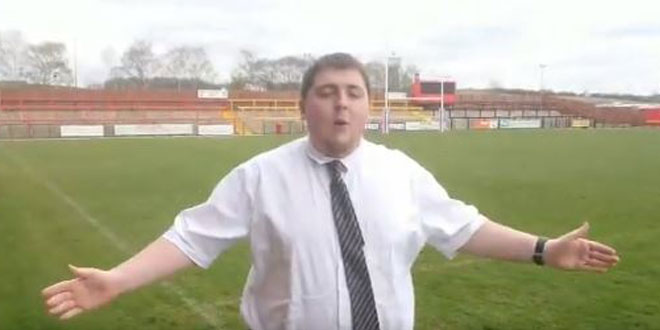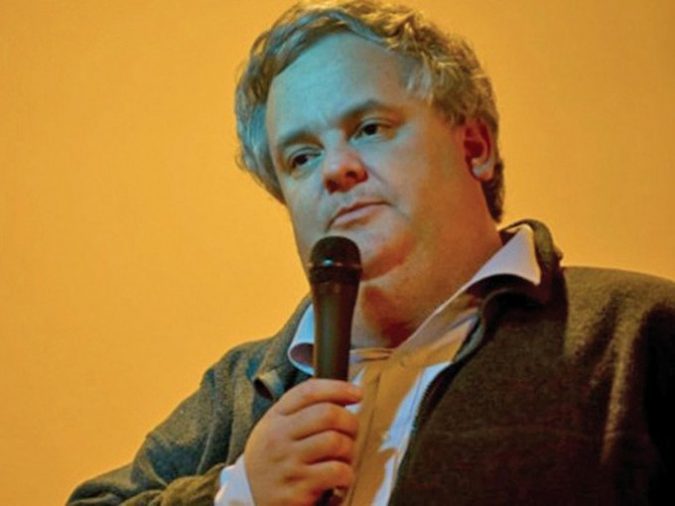
1. Their media and marketing manager became a social media sensation.
Dewsbury’s Steve Downes, who works in the club’s off-field staff, had been producing video previews for all the club’s home fixtures. They had a fairly humble following that extended no further than the Rams’ dedicated contingent. That was, until the run-up to their Good Friday clash with rivals Batley Bulldogs in 2019. In the preview video, where Downes used his developing catchphrase “hello and welcome to the Tetley’s Stadium, the home of the Dewsbury Rams,” he showed his raw passion for the game and his lighter side by mentioning a “fun egg and spoon race” before the game. Over 40,000 people would see the video, attracted by Downes’ larger-than-life character, which accounts to four times more people than the club’s Twitter following. Promotional appearances at Leeds Rhinos and Wigan Warriors would follow, for Downes, as would an interview with the RFL on their website. Dewsbury forward Martyn Reilly later produced a parody video, sporting Downes’ trademark off-grey shirt and black tie, as the Dewsbury staff member remains one of the sport’s most-loved social media stars.
2. The club were hit by a pandemic and had to play games behind closed doors… over 100 years ago.
Rugby League has been halted by the COVID-19 crisis, but that wasn’t the first time a pandemic has hit the sport. In December 1904, Huddersfield and Dewsbury met for a 3-3 draw, behind locked doors. This was because the community of Dewsbury had suffered from an outbreak of smallpox. Just a handful of games into the season, Bramley refused to travel to face Dewsbury, despite the home side offering an isolation tent for the travelling party. The Northern Union forced Bramley to pay £7 to Dewsbury in compensation, with Rochdale being slapped with a £20 fine for the same offence. Dewsbury were able to travel to face Castleford and York, but disappointing attendances due to the pandemic worsened their cause. There were genuine fears the club would fold, but the League Management Committee maintaining that clubs would be fined for not playing at Dewsbury. The club then returned to action, after a month without a game, against Barrow and returned to win 17 games in a row. They were Second Divisions champions, losing only four games. What pandemic?
3. Their star player shocked the sport by murdering his wife.

The picture above really has a different resonance when you find out what you’ve just read about this man. William ‘Buller’ Stadden had earned a fierce reputation in rugby union and was described as “Wales’ first rugby star” when he moved to Dewsbury RFC in 1886 from Cardiff. He excelled in the Heavy Woollen district, and was part of the founding Dewsbury RLFC squad after being elected to the Northern Union in 1898. Now Stadden was never a cleaner-than-clean character in the sport, he turned down a place on the inaugural Lions tour because he was unhappy with the financial terms and worked for Dewsbury chairman Mark Newsome’s mill, all this when amateurism was supposed to be upheld at all times. His actions on Christmas Day 1906, however, are beyond comprehension. After attending a game between Dewsbury and Wakefield, on that Christmas Day, Stadden strangled his wife to death and then attempted to commit suicide. All while his five children and lodger remain in the house. A blood-stained knife was discovered in his house, as he died three days later. A truly horrific act, Stadden stained his reputation as one of the game’s early pioneers.
4. They signed a raft of South African players ahead of the 1996 season.
Super League had just hit the sport and it would seem that international experiments were the new trend. Dewsbury clearly got that memo, adding five South African players in 1996. Then Dewsbury coach Tony Fisher had coached the nation at the 1995 Rugby League World Cup, their first appearance, in which they lost in big defeats to England and Australia. Fisher was, however, compelled enough by the some of the performances of his side, as he drafted in Guy Coombe, Tim Fourie, Jaco Booyens, Kobus Van Deventer and Pierre Van Wyke. The quintet would only stay on board for the 1996 season, however, as they all returned home after a largely unsuccessful venture at Dewsbury. Fourie would later return to the UK, with Leeds Tykes in 1998, and became a well-respected figure in the other code. Van Deventer went on to play rugby union in the USA, while Coombe would return to rugby union in South Africa. As would Booyens and Van Wyke, with both featuring at the 2000 World Cup for their homeland, their last appearance at the finals.
5. Three of their key staff were once invited to visit the Prime Minister.

Following their invincible season in 2009, which saw them win the Championship 1 and win all 18 games of the season, head coach Warren Jowitt, chairman Mark Sawyer (above) and director Mark Woodhead were invited to Number 10 Downing Street. It would appear a shock move, on reflection, as the 13-man code hasn’t had it’s fair share of visits to the famous property, with the 2013 World Cup launch being the only formal one that serves to memory. Then Prime Minister Gordon Brown invited Jowitt and Sawyer to celebrate their feat, following a nod from Dewsbury and Mirfield MP Shahid Malik. As a random side note, there have been two Prime Ministerial namesakes in Rugby League. Gordon Brown was a former Great Britain, Leeds and Keighley stand-off in the 1950s and Stanley Baldwin, a namesake of the twice Prime Minister, played for Rochdale in the 1930s.
